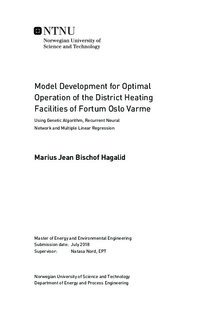Model Development for Optimal Operation of the District Heating Facilities of Fortum Oslo Varme - Using Genetic Algorithm, Recurrent Neural Network and Multiple Linear Regression
Master thesis
Permanent lenke
http://hdl.handle.net/11250/2614837Utgivelsesdato
2018Metadata
Vis full innførselSamlinger
Sammendrag
Recent development in the energy sector in Norway has made district heating increasingly relevant. In particular, the increased demand for electric power, has contributed to make district heating more important.
A well known problem in district heating, is operational optimization. In this thesis, the problem is investigated on the basis of the Fortum Oslo Varme s system, which consists of more than 40 boilers. All data used in the thesis is gathered from Fortum s data system.
Another prominent theme in district heating, is the possibility for building thermal energystorages. Methods which can calculate the profitability of investing in thermal energy storages are necessary.
To solve the issue of operational optimization, models for predicting future heat load demandare necessary. Two such models were developed, the best of which were able to predict the heat load demand with an average error of 7.6% in the years 2013 and 2014.
Additionally, a model for operational optimization was developed. It can be run both withand without an accumulator tank, so that the operational cost can be compared, and investmentdecisions can be taken. It was found that a system with an accumulator tank can save 1.3 million NOK yearly, based on simulations performed on data from 2016. The investment in a tank is not profitable, given an assumed cost of 39 million NOK.
It must, however, be taken into account that potential savings will vary between years. Thesimulations also build on some assumptions about the district heating system, and the thermalenergy storage. Since the optimization model is based on randomness, two consecutiveruns would not give the same result. Therefore, additional simulations are required to verify the results.
